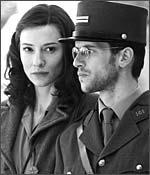 | « Back to article | Print this article |
Steven Soderbergh's latest film, The Good German, is set in post-war Berlin circa 1945. Truman, Stalin and Churchill are to meet in Potsdam for the last time as allies to discuss the division of German assets between themselves -- the 'victors' in the War. The city has been divided into zones, its residents live in fear and everywhere, the unscrupulous are capitalising on the misfortune of others to get rich quick.
George Clooney plays Jacob Geismer, an American journalist in town to cover the conference. He was stationed in Berlin before the war and he's back for more than just the peace conference. Before the war forced him to leave, he had fallen in love with Lena (Cate Blanchett), a married woman who worked for him. The very same Lena who is now the girlfriend of Tully, the creepy young American driver (Tobey Maguire) assigned to drive Geismer around during his stay in Berlin.
Upon his arrival, Geismer's wallet is stolen. Not too long after that he finds, loses and finds Lena again. While trying to solve Lena's problems he ends up getting punched by almost everybody in the movie. He is on the scene when a murder victim is discovered and as the puzzle comes together he has to persevere with his dual quests for truth and Lena's escape from Berlin.
Director Steven Soderbergh is already well known for his experimentation with filmmaking styles and genres. He has made intensely personal films as well as big budget spectaculars. He has tackled the scale required to win an Oscar as well as designing content to fit a radical distribution strategy. So it's no surprise that he chose a decidedly 1940s style of filmmaking for this movie. Production notes from old movies were consulted, camera lenses were adopted and wireless microphones were abandoned so that the film could be shot authentically on soundstages and backlots they way it was done 60 years ago.
The film was framed and lit a la Casablanca and The Third Man. Though the movie is based on a best-selling
 While The Good German adheres to the stylistic code of the 1940s it diverts from the script in one very important way. There is violence and nudity that would have been banned back then. While the actors may look well-preserved from a bygone era, they swear like people from the present. That disconnect, coupled with the over-reliance on the look instead of the 40s feel is what eventually makes German an exercise in style over storytelling.
While The Good German adheres to the stylistic code of the 1940s it diverts from the script in one very important way. There is violence and nudity that would have been banned back then. While the actors may look well-preserved from a bygone era, they swear like people from the present. That disconnect, coupled with the over-reliance on the look instead of the 40s feel is what eventually makes German an exercise in style over storytelling.
As far as performances go the cast does a good job, especially Blanchett in her role as the reluctant femme fatale -- an impressive glacial blend of Marlene Dietrich and Ingrid Bergman is impressive. Tobey Maguire plays a chilly, very effective creep. And Clooney, as always, is cool and classy. The Good German serves to underline that an age of blogs and tabloids makes it more difficult than ever to imagine movie stars as black and white legends preserved on celluloid.
That being said, this is more of a triumph in Soderbergh's experimental filmography than some of his past endeavours at jarring the mainstream. Watch it to see what today's stars would look like in a bygone era. Watch it to imagine, briefly, what the movie going experience must have been like back then.
Everything else is window dressing.
Rediff Rating: